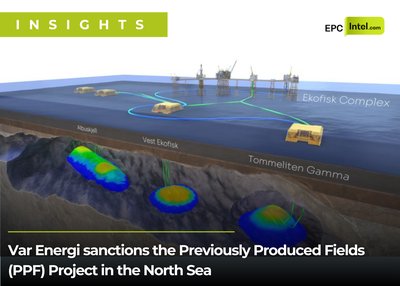The offshore oil & gas sector might not always be at the forefront of energy conversations, but based the data in the energy EPC contract database on EPCIntel.com, it’s clear this industry isn’t just coasting along. Offshore oil is still pulling in billions of dollars, with megaprojects continuing to rise from the depths. That said, we’re not in the wild days of freewheeling investment either. Over the next five years, the sector is poised for growth, but there’s a sense that the industry is more measured, cautious even, about the future. Offshore oil isn’t dying—it’s evolving. The days of unrestrained spending might be over, but the long-term value of deepwater oil is still very much alive.
Big bets on big projects
Let’s start with the projects that are making waves. Brazil’s pre-salt fields, especially Petrobras’s flagship Búzios field, are massive undertakings that have the world’s oil giants doubling down on deepwater. Brazil remains a hotbed for offshore investment, and with good reason—the scale and profitability of these fields are unmatched. The investments here are impressive, with billions already committed, and they promise long-term paybacks that make it clear the industry isn’t betting on a quick energy transition away from oil. These fields are the kind of megaprojects that span decades, not years. Petrobras isn’t thinking about 2025; they’re thinking about 2040 and beyond.
Guyana is another offshore frontier that’s commanding attention. ExxonMobil’s projects in the Stabroek block, including the Liza and Payara fields, are nothing short of massive. Guyana’s deepwater fields are proving to be among the most lucrative offshore plays in recent memory, and they’re fast becoming central to Exxon’s growth strategy. Like Brazil, these aren’t short-term plays. Exxon’s commitment to Guyana isn’t just about riding the next oil wave; it’s about securing a seat at the table for the next several decades of energy production.
Mozambique, too, is a region that’s shaping up to be a powerhouse, particularly with liquefied natural gas (LNG) projects. TotalEnergies and ExxonMobil are leading the charge here, though security concerns have slowed things down. Still, these projects—like the Area 1 LNG and Rovuma LNG developments—will be game-changers when they come online. LNG is a crucial bridge fuel in the transition to a lower-carbon world, and offshore gas plays are poised to deliver massive returns in the coming decades.
Confident momentum remains
While these big projects are charging ahead, it’s worth noting that we’re not in the same offshore boom cycle we saw a decade ago. Yes, there’s still a lot of money flowing into the sector, but companies have gotten smarter about where and how they invest. Gone are the days of throwing cash at every deepwater prospect with reckless abandon. Today’s offshore investments are focused, disciplined, and built around projects that can deliver solid returns even in a lower-price environment.
That’s a reflection of the broader market. Global oil demand is still growing, but at a slower pace than in the past. Renewables are eating into the growth story, but oil, especially from offshore fields, remains indispensable—particularly for industries that can’t easily transition to green alternatives. Think aviation, heavy manufacturing, shipping, and petrochemicals. Offshore oil, with its massive, long-term reserves, is crucial to meeting this demand.
However, there’s no denying the fact that energy companies are now juggling two realities: the need for oil and gas today and the pressure to transition to cleaner energy sources tomorrow. This is where the ESG (Environmental, Social, and Governance) movement has made its mark.
Oil & gas companies are under pressure to show they’re lowering their carbon footprint, even as they continue to invest in hydrocarbons. Offshore oil has adapted by integrating more efficient, lower-emission technologies into operations. Electrifying offshore platforms, using renewable power for production, and enhancing carbon capture technologies are all ways the industry is evolving.
CAPEX growth with CAPEX selectivity
Looking ahead, global CAPEX in the offshore oil and gas sector is expected to rise steadily, though not explosively. Rystad Energy forecasts that CAPEX will reach around $180 billion by 2027, fueled by sanctioned megaprojects in Brazil, Guyana, and Africa. However, the industry is more selective now. The days of a scattershot approach to exploration are largely over. Companies are laser-focused on high-impact projects with strong returns and lower risks. The focus has shifted toward deepwater fields with proven reserves, rather than speculative greenfield projects.
There’s a bullishness in these long-term investments, no doubt about it. But companies are also hedging their bets. It’s not that they’re unsure about the future of oil demand—they’re just more aware of how the energy landscape is shifting. Offshore projects take years, if not decades, to deliver their full value. But the industry clearly believes that even with the energy transition underway, oil will still be a major player in the global energy mix for at least another 20-30 years.
Production boom, but is it reaching a plateau?
When it comes to production, offshore oil is set for a period of solid growth. We’re expecting global offshore oil production to hit a peak of around 28 million barrels of oil equivalent per day by 2026. That’s a serious volume, driven by megaprojects that are set to come online over the next few years. Brazil and Guyana are going to be leading this charge, with other regions like West Africa contributing significantly.
But after 2026, we may start to see a plateau. It’s not that production will suddenly fall off a cliff, but the rate of growth could slow. Part of this is because the industry is becoming more capital-efficient, but part of it is also due to the shifting global energy demand. With the rise of renewables and EVs, the world’s appetite for oil might not continue its relentless climb forever. That said, even a plateau at these production levels signals a robust and stable future for offshore oil.
Offshore isn’t going away but it’s changing
So, where does this leave us? Offshore oil is clearly still in the game and ready to thrive in the next five years and beyond. The massive projects being sanctioned today—especially in Brazil, Guyana, and Mozambique—are setting the stage for long-term growth. But this isn’t the same industry it was 20 years ago. Companies are more disciplined, more efficient, and more aware of the need to balance oil production with the demands of a decarbonizing world.
The future of offshore oil looks bright, but it’s a future that’s more complex than ever. The next five years will see growth, innovation, and a steady stream of new projects. But beyond that, the industry will need to adapt even more as global energy markets continue to evolve. Offshore oil isn’t dying—it’s changing. And if the industry plays its cards right, it could remain a cornerstone of global energy well into the middle of this century.
Image by EPCIntel.com




